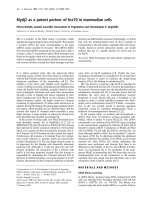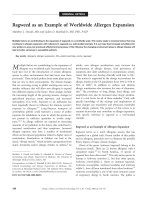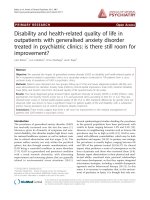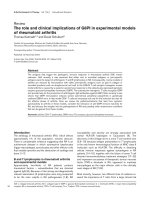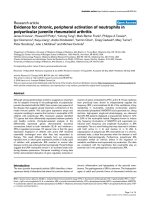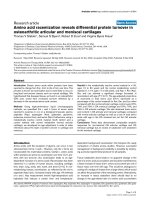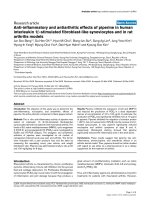Báo cáo y học: "Neurocysticercosis as an important differential of seizures in pregnancy: two case reports" pdf
Bạn đang xem bản rút gọn của tài liệu. Xem và tải ngay bản đầy đủ của tài liệu tại đây (297.72 KB, 3 trang )
CAS E REP O R T Open Access
Neurocysticercosis as an important differential of
seizures in pregnancy: two case reports
Savita R Singhal
1*
, Smiti Nanda
1
and Suresh K Singhal
2
Abstract
Introduction: Seizures in pregnancy usually result from eclampsia, epilepsy or central nervous system disorders.
Neurocysticercosis is a rare, but an important, cause of first-time convulsions in pregnancy.
Case presentations: We report the cases of two Indian women, aged 20 and 24 years old respectively, with
neurocysticercosis presenting in the second trimester of pregnancy with convulsions. Both had marginally raised
blood pressure with 1+ urine albumin and neither had a past history of convulsions. The neurocysticercosis was
diagnosed on magnetic resonance imaging of the head, which showed spherical ring-enhancing lesions in the
brain. In one woman, pregnancy was terminated due to spina bifida in the fetus and she was discharged on
albendazole and phenytoin. The second woman was put on carbamazepine: she had an emergency Cesarean
section at term for fetal distress and delivered a heal thy baby. Her postnatal period was uneventful.
Conclusion: Neurocysticercosis should be considered in pregnant women presenting with seizures which cannot
be explained by eclampsia, especially in early pregnancy.
Introduction
Seizures in pregnancy usually result from eclampsia, epi-
lepsy or central nervous system disorders. Neurocysti-
cercosis, although rare, is an important cause of first-
time convulsions in pregnancy. Del Brutto has proposed
certain definitive and probable criteria for the diagnosis
of neurocysticercosis: histology; imaging; epidemiology;
serology; clinical symptoms; and follow-up scans [1].
Magnetic response imaging (MRI) is superior to a com-
puted tomography (C T) scan in diagnosis and fo llow-up
studies [2]. The signs and symptoms range from a single
seizure to coma and death. It can be treated with mini-
mal interruption to the course of the pregnancy and
medical treatment is effective in most cases although
surgery may be indicated for a few women [3]. We
report two cases of neuroc ysticercosis in women who
presented with convulsions in the second trimester of
their pregnancy.
Case presentations
Case 1
A 20-year-old Indian woman who was an unbooked pri-
migravida presented as an emergency at 27 weeks of gesta-
tion with generalised tonic clonic seizures over a six hour
period. She had been uncons ciousness for one hour. She
was referred by a general practitioner with a diagnosis of
eclampsia. There was n o past history of seizures and she
was not on any medication. On examination, she was in a
grade III coma and her pulse and blood pressure were 92
beats/min and 130/90 mmHg, respectively. Her urine
albumin was +1 and the liver function, renal function and
fundus examinations were normal. An ultrasound showed
a live 26-week-size fetus with spina bifida. An emergency
MRI of our patient’ sheadshoweda4-5mmspherical
ring-enhancing lesion in the frontal region of her brain. A
diagnosi s of neurocysticercosis was made on the basis of
the MRI finding, symptoms and living in an endemic area.
She was put on intravenous phenytoin and the pregnancy
was terminated in view of the fetus’ spina bifida with miso-
prostol. She aborted after 16 hours and regained con-
sciousness after 24 hours: she was discharged on
albendazole and phenytoin.
* Correspondence:
1
Department of Obstetrics and Gynecology, Pandit Bhagwat Dayal Sharma,
Post Graduate Institute of Medical Sciences, Rohtak (124001), Haryana, India
Full list of author information is available at the end of the article
Singhal et al. Journal of Medical Case Reports 2011, 5:206
/>JOURNAL OF MEDICAL
CASE REPORTS
© 2011 Singhal et al; licensee BioMed Central Ltd. This is an Open Access article d istribu ted under t he terms of the Creative Commons
Attribution License ( which permits unrestricted use, distribution, and reproduction in
any medium, provided the original work is properly cited.
Case 2
A 24-year-old Indian woman who was a booked primi-
gravida presented at 24 weeks of gestation with a history
of one generalized tonic clonic seizure 30 minutes
before. She had no past history of convulsion. On exam-
ination she was conscious, alert and had a blood pres-
sure of 140/100 mmHg. There was +1 albuminuria.
Fundus, renal and liver function tests were normal. She
became normotensive after 24 hours. An MRI of her
head reported a single cystic enhanced lesion in the par-
ietal lobe of the brain (Figure 1). A diagnosis of neuro-
cysticercosis was made on the basis of the MRI,
convulsion and living in an endemic area. She w as put
on carbamazepine and discharged from the hospital
after two days. She was followed-up regularly t hrough-
out the pregnancy. The remainder of her antenatal per-
iod was uneventful but, at term, she had an emergency
Cesarean section due to fetal distress. Her postnatal per-
iod was uneventful and she was discharged in good con-
dition with a healthy baby.
Discussion
Convulsions during pregnancy reported to an obstetri-
cian are mainly due to eclampsia. A complete and con-
tinuous evaluation is crucial to differentiate eclampsia
from other disorders. When atypical features are pre-
sent, or clinical status worsens, neuroimaging is impor-
tant [4]. In both these reported cases there was
marginally raised blood pressure; +1 albuminuria; no
past history of any seizures; and both women presented
in the second trimester. Marginally raised blood pres-
sure and +1 urine albumin may be present in acute
stages of convulsions. In both women, the MRI was sug-
gestive of neurocysticercosis.
The first case was misdiagnosed as ecla mpsia at per-
iphery. There was a small possibility of eclampsia as her
blood pressure was only 130/90 mmHg and only +1
urine a lbumin. Bearing this in the mind, an emergency
MRI of the head was done which detected the spherical
ring-enhancing lesion. The diagnosis of neurocysticerco-
sis was made on the basis of MRI findings, symptoms
and living in an en demic area. She presented in a very
bad state with a grade III coma as she had multiple sei-
zures over a period of six hours. The second woman
was in quite good condition in spite of having suffered a
seizure. Thus, the presentation may be variable from a
single episode to multiple seizures.
Neurocysticercosis is usually misdiagnosed as eclamp-
sia and can be differentiated by imaging studies as in
these two cases. MRI is superior to a CT scan in such
Figure 1 MRI of the brain of the patient in case 2 showing a single cystic enhanced lesion.
Singhal et al. Journal of Medical Case Reports 2011, 5:206
/>Page 2 of 3
cases [2]. During pregnancy, treatment of neurocysticer-
cosis consists of anti-convulsant therapy. Anti-hel-
minthic drugs should be delayed until post-partum [5].
Conclusion
Neurocysticercosis should be considered as a possible
diagnosis in pregnant women pre senting with seizures
which cannot be explained by eclampsia, especially in
early pregnancy.
Consent
Written informed consent was obtained from both
patients for publication of these case reports and any
accompanying images. A copy of the written consent is
available for review by the Editor-in-Chief of this
journal.
Author details
1
Department of Obstetrics and Gynecology, Pandit Bhagwat Dayal Sharma,
Post Graduate Institute of Medical Sciences, Rohtak (124001), Haryana, India.
2
Department of Anesthesiology, Pandit Bhagwat Dayal Sharma, Post
Graduate Institute of Medical Sciences, Rohtak (124001), Haryana, India.
Authors’ contributions
Both the patients were admitted under the supervision of SN. SRS did the
Cesarean section for one patient and terminated the pregnancy in the
other. SKS gave anesthesia to the patient and helped to collect the literature
for this report. SRS and SN wrote the article. All the authors have read and
approved the final manuscript.
Competing interests
The authors declare that they have no competing interests.
Received: 5 November 2009 Accepted: 26 May 2011
Published: 26 May 2011
References
1. Del Brutto OH, Rajshekhar V, White AC Jr, Tsang VC, Nash TE,
Takayanagui OM, Schantz PM, Evans CA, Flisser A, Correa D, Botero D,
Allan JC, Sarti E, Gonzalez AE, Gilman RH, García HH: Proposed diagnostic
criteria for neurocystecercosis. Neurology 2001, 57(2):177-183.
2. Garcia HH, Del Brutto OH: Imaging findings in neurocysticercosis. Acta
Trop 2003, 87(1):71-78.
3. Saurez VR, Iannucci TA: Neurocysticercosis in pregnancy: a case initially
diagnosed as eclampsia. Obstet Gynecol 1999, 93(5 Pt 2):816-818.
4. Richards AC Jr: Neurocysticercosis cercosis: a major cause of neurological
disease worldwide. Clinical Infect Dis 1997, 24(2):101-115.
5. Flisser A, Madrazo I, Plancarte A, Schantz P, Allan J, Craig P: Neurological
symptoms in occult neurocysticercosis after single taeniacidal dose of
praziquantel. Lancet 1993, 342(8873):748.
doi:10.1186/1752-1947-5-206
Cite this article as: Singhal et al.: Neurocysticercosis as an important
differential of seizures in pregnancy: two case reports. Journal of Medical
Case Reports 2011 5:206.
Submit your next manuscript to BioMed Central
and take full advantage of:
• Convenient online submission
• Thorough peer review
• No space constraints or color figure charges
• Immediate publication on acceptance
• Inclusion in PubMed, CAS, Scopus and Google Scholar
• Research which is freely available for redistribution
Submit your manuscript at
www.biomedcentral.com/submit
Singhal et al. Journal of Medical Case Reports 2011, 5:206
/>Page 3 of 3

